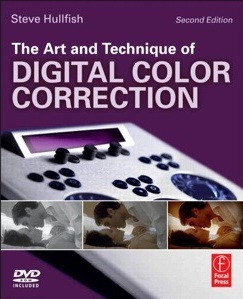Book Review: The Art and Technique of Digital Color Correction

Color processing was used with film even before the adoption of color film. Hand painted animation or monochromatic dyed prints were common more than a century ago. The art of color timing came to prominence with color film though. Timing, itself, related to the duration of the various chemical baths. Chemistry was later mostly replaced by colored printing lights and color manipulation usually happened during intermediate printing. Then digital intermediate came and changed cinematography significantly.
It is hard to overestimate the importance of the post-process adjustments. While a lot of old-school cinematographers still largely create the image in-camera, the new wave thinks of the colorist as one of the most important links in the production chain. The paradigm shooting for post is popular for a reason. With digital image manipulation the creative possibilities are endless. And so is the lack of restraint, but that’s another story.
Color correction and color grading are often used interchangeably. But there are nuances. Or at least we can inject different notions for terminology precision. Color correction is more appropriate to describe the process of fixing, adjusting and matching footage. Color grading is then furthering an artistic vision or creating a look. Looks are all the rage now. At any level of experience, and for any kind of visual media, you can get fast looks (kinda rhymes with fast food) with Instagram, Hipstamatic, Magic Bullet Looks, etc. Being derivative is easier than ever.
So, after this short introduction with a touch of rant, let’s talk a bit about the book from the title. The Art and Technique of Digital Color Correction by Steve Hullfish is a clever book. Its cleverness is coming from the fact that it is largely software agnostic in its description of the tools of the trade. Knowing the principles of a specific color tool means you can go beyond the implementation differences between various software packages. And there certainly is an abundance of tools for video color correction. Each one appropriate for specific tasks or specific approaches. Actually, someone coming from the still photo world may raise an eyebrow. After all, Curves should be enough for almost everything, right?
The book introduces the terminology and the main control tools of the color correction process: the vectorscope and the waveform monitor. And goes into details about how to use them in the color correction process. Both primary and secondary color correction are covered. Primary color correction mostly fitting in the definition of color correction above, and secondary color correction being essentially localized fixes, relighting and color grading. These include basic tonal adjustments, global color adjustments, and the various ways of qualifying image elements for secondaries.
One of the cool things about this book is that topics are disclosed by describing various pros tackling various tasks. Getting a glimpse of the working process of experienced colorists is really helpful. You can work out and synthesize a method by analyzing their approaches, similarities and differences. There is never a single way to do things. And you can pick small tips and tricks on the way. Of particular interest are the more advanced topics, some of them going further beyond the technical side of things: matching shots, color as a storytelling element, creating looks, and communicating with a cinematographer/videographer. The latter, of course, applies when the videographer and the colorist are not the same person, an uncommon case in the low budget world.
It is important to note that The Art and Technique of Digital Color Correction is strictly about creative and technical color manipulation in post. It doesn’t teach about color science and color spaces. It doesn’t talk much about setting and calibrating a color correction suite. It doesn’t concern itself with camera color: color matrices, color profiles, picture profiles, etc. It doesn’t teach how to get accurate color during shooting, through color charts on set or otherwise. Some of these topics are covered in another book co-authored by Steve (with Jaime Flower): Color Correction for Video.

What is your opinion on Color Correction handbook by Alexis Van Hurkman?